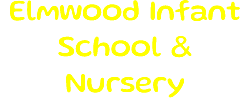
At Elmwood Infant School, we use the document ‘Letters and Sounds’ to plan for the teaching of phonics. We start teaching children in Nursery Phase One, which allows children to become aware of the sounds they hear in their immediate environments, as well as the sounds they can create themselves, using their body or instruments. We also concentrate on developing their speaking and listening skills. Phase one is divided into seven aspects, which looks at environmental, instrumental, body and voice sounds and rhythm, rhyme and alliteration. It also looks at oral blending and segmenting in words.
As children move into Reception they continue to build on their listening skills and are introduced to Phase 2, which teaches children 23 phonemes, in order for children to blend sounds together to read words, captions and sentences. Once the children are secure, the children move on to the next phase, where they will learn new sounds. The next phase is phase 3 which teaches children the remaining 7 letters of the alphabet, digraphs (two letters than make one sound) and trigraphs (three letters that make one sound). Again once secure, children will move onto Phase 4 when they are ready. Phase 4 does not teach the children any new sounds. Children learn how to decode and blend words with the sounds they have learnt including longer words with adjacent consonants. In the Early years, there is a phonics focus in the outdoor area which exposes children to reading and writing activities allowing them to practise what they have learnt. As well as this, each class display a sound of the week so that parents are aware of the sounds they are learning as well as sounds that have been taught.
In year 1, children recap their learning in reception and then learn the sounds in phase 5. They learn alternative graphemes for the phonemes they have learnt. For example; ai, ay, a_e. As well as this, children learn different ways of pronouncing graphemes they already know. For example; ai—said, mountain. Children work through the different phases and as they grow in confidence and experience. Once children are secure in phase 5, they will move on to phase 6 within year 2. The children will then work on sound families, alternative sounds, spelling patterns, and develop the use and understanding of prefixes and suffixes.
All children have discrete, daily phonics sessions everyday between 9.15 and 9.45 where they revise previous learning and sounds, are taught new phonemes and graphemes, practise the sounds they have learnt and apply their learning. Throughout the school, children are taught in small and focussed groups to target their specific needs, alongside children of the same ability. At the beginning of the year as children settle into school, children in Reception are taught by their class teacher. Teachers and Teaching Assistants regularly assess the children in their groups and liaise with the teacher so that all planning meets the needs of the children in that group, therefore ensuring all children are confident before moving onto a new phase.
Through phonics, reading and writing sessions, children are taught to use their sounds to read and write. Children work through the different phases depending on their progress which is assessed by their class teacher. Assessments are carried out every half term in order to identify gaps, to ensure children are moving through the phases and are being sent home with a correctly matched phonetically decodable book. In year 1, children receive a phonic flyer each week covering all of the phases in order to support children with their sounds at home. At the end of year 1, all pupils complete the phonics screening check which is a national assessment which consists of 40 words which the children have to read. Within those 40 words, are pseudo words which have no meaning. If a child does not pass the phonics screening check, they will receive extra support in year 2 and re-take the phonics screening check at the end of year 2.
Phonics is linked to the teaching of reading in our school. Children take home ‘learning to read’ books’ which are matched to the sounds children are confidently using. ‘Learning to read’ books are to be shared at home over a few evenings so the children explore the different aspects of reading. Firstly, they decode the words in the text and blend the sounds together, next, they should read the story fluently and then again to understand what is happening in the story, the language used and to retell the key parts of the story. As well as these books, children take home ‘Reading for Pleasure’ books which allows children to read books chosen by their interests. These books expose them to a wider range of words and vocabulary, authors and illustrations.
Literacy around our school
no images were found
